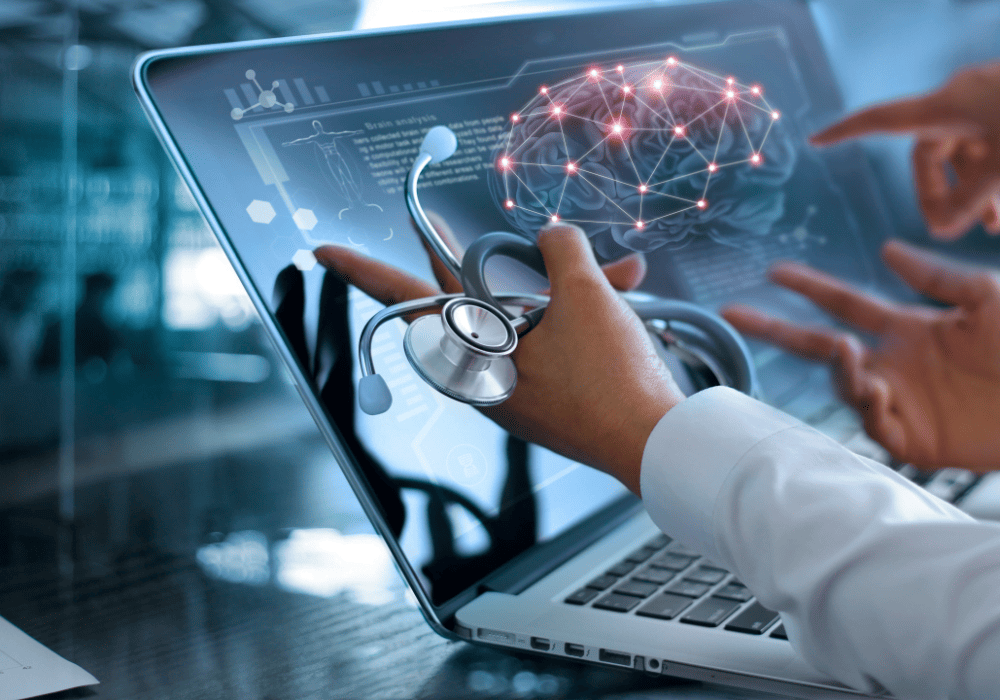The healthcare industry has always been at the forefront of innovation, and the integration of technology is transforming it in ways that were once unimaginable. From artificial intelligence (AI) to telemedicine, technology is reshaping how healthcare is delivered, managed, and experienced. Here are several significant ways technology is changing the healthcare landscape:
1. Telemedicine: Expanding Access to Care
Telemedicine has emerged as a pivotal advancement, particularly highlighted during the COVID-19 pandemic. By enabling healthcare providers to conduct virtual consultations, telemedicine breaks down geographical barriers, allowing patients to access healthcare services from the comfort of their homes. This is especially beneficial for individuals living in rural areas, where healthcare facilities may be limited.
Moreover, telemedicine reduces wait times and increases convenience for patients, leading to improved adherence to medical advice and treatment plans. By leveraging video conferencing tools, patients can receive immediate attention for non-emergency issues, significantly enhancing the efficiency of healthcare delivery.
2. Wearable Technology: Monitoring Health in Real Time
Wearable technology, such as smartwatches and fitness trackers, has revolutionized personal health monitoring. Devices equipped with sensors can track vital signs like heart rate, blood pressure, and oxygen saturation. This data is invaluable for both patients and healthcare providers, allowing for proactive management of health conditions.
For example, wearables can alert users to irregularities in their health data, prompting them to seek medical attention before a minor issue escalates into a serious problem. Additionally, healthcare providers can use this continuous stream of data to tailor treatment plans and monitor patient progress more effectively.
3. Artificial Intelligence: Enhancing Diagnostics and Treatment

AI is making waves in the healthcare industry by improving diagnostic accuracy and personalizing treatment plans. Machine learning algorithms can analyze vast amounts of data, including medical images and patient records, to identify patterns that may not be visible to the human eye.
For instance, AI-powered tools can assist radiologists in detecting abnormalities in X-rays and MRIs, leading to earlier and more accurate diagnoses of conditions such as cancer. Moreover, AI can predict patient outcomes and suggest the most effective treatment options based on individual patient data, thereby enhancing the overall quality of care.
4. Electronic Health Records (EHRs): Streamlining Information Sharing
The transition from paper-based records to electronic health records (EHRs) has streamlined patient information management. EHRs allow healthcare providers to store, access, and share patient information securely and efficiently. This not only enhances communication among healthcare teams but also reduces the risk of errors associated with handwritten records.
EHRs enable providers to have a comprehensive view of a patient’s medical history, including allergies, medications, and previous treatments. This holistic perspective allows for better-informed decision-making and coordination of care, ultimately improving patient outcomes.
5. Health Apps: Empowering Patients to Take Charge of Their Health
Mobile health applications are empowering patients by providing them with tools to manage their health proactively. From medication reminders to symptom trackers, these apps help individuals take charge of their health and wellness. Many health apps also offer educational resources, allowing users to learn more about their conditions and treatment options.
Additionally, some applications facilitate direct communication with healthcare providers, enabling patients to ask questions and receive guidance without needing to schedule an in-person appointment. This enhanced accessibility fosters a collaborative approach to healthcare, where patients and providers work together to achieve better health outcomes.
6. Blockchain: Securing Patient Data
As the healthcare industry increasingly relies on digital solutions, the need for secure data management has become paramount. Blockchain technology offers a robust solution for securing patient information and ensuring data integrity. By creating a decentralized and tamper-proof ledger, blockchain enhances the security of EHRs and other sensitive health data.
This technology not only protects against data breaches but also enables secure sharing of patient information among healthcare providers. Patients can have greater control over their data, granting access only to authorized parties and enhancing their privacy.
7. Robotics: Revolutionizing Surgery and Patient Care

Robotic-assisted surgeries have gained popularity due to their precision and minimally invasive nature. These advanced systems allow surgeons to perform complex procedures with greater accuracy, leading to reduced recovery times and fewer complications for patients.
Beyond surgery, robotics is also being integrated into patient care settings. For instance, robots can assist with routine tasks such as medication delivery and patient monitoring, allowing healthcare professionals to focus on more critical aspects of patient care. This not only enhances operational efficiency but also improves patient experiences.
8. Big Data Analytics: Informed Decision-Making
The healthcare industry generates vast amounts of data daily, and big data analytics is transforming how this information is utilized. By analyzing large datasets, healthcare providers can identify trends, improve patient care, and optimize operational efficiency.
For example, data analytics can help hospitals predict patient admissions, enabling them to allocate resources more effectively. Furthermore, analyzing patient data can reveal insights into treatment efficacy, leading to evidence-based practices and improved patient outcomes.
9. Personalized Medicine: Tailoring Treatment to the Individual
Advancements in genomics and biotechnology are paving the way for personalized medicine, which tailors treatment plans to individual patients based on their genetic makeup. This approach allows healthcare providers to choose therapies that are more likely to be effective for specific patient populations.
For instance, cancer treatment can be customized based on a patient’s genetic profile, increasing the likelihood of successful outcomes while minimizing adverse effects. As our understanding of genetics continues to grow, personalized medicine is poised to become a standard practice in healthcare.
10. Remote Monitoring: Keeping Patients Safe at Home

Remote patient monitoring (RPM) technologies are enabling healthcare providers to keep track of patients’ health outside of traditional clinical settings. This is particularly beneficial for individuals with chronic conditions who require ongoing monitoring.
Devices that measure parameters such as glucose levels, blood pressure, and heart rate can transmit data to healthcare providers in real time, allowing for timely interventions when necessary. This not only enhances patient safety but also reduces the need for frequent office visits, making healthcare more accessible and efficient.
11. Virtual Reality (VR) and Augmented Reality (AR): Enhancing Training and Treatment
Virtual reality and augmented reality technologies are finding their place in healthcare, primarily in training and therapeutic applications. Medical students and professionals can utilize VR simulations to practice surgical techniques and enhance their skills in a risk-free environment.
Moreover, VR and AR can be used in patient treatment, particularly for pain management and rehabilitation. For instance, patients undergoing physical therapy can engage in immersive VR experiences that distract from pain and enhance motivation during their recovery process.
12. 3D Printing: Customizing Medical Solutions3D printing is revolutionizing the way medical devices and prosthetics are manufactured. This technology allows for the creation of customized solutions tailored to individual patient needs. For example, 3D-printed implants can be designed to fit perfectly within a patient’s anatomy, improving surgical outcomes and reducing recovery times.
Additionally, 3D printing is being explored for creating tissue and organ models, which can aid in surgical planning and education. As the technology continues to evolve, its applications in the healthcare sector are expected to expand significantly.
13. Artificial Intelligence in Drug Discovery
AI is also playing a crucial role in drug discovery, helping researchers identify potential compounds and predict their efficacy much faster than traditional methods. By analyzing biological data and existing literature, AI can streamline the drug development process, significantly reducing the time and costs associated with bringing new medications to market.
This innovation holds the potential to revolutionize treatment options for various diseases, making it possible to develop targeted therapies more efficiently.
14. Patient Engagement Platforms: Fostering Communication
Patient engagement platforms are enhancing communication between healthcare providers and patients. These platforms allow for seamless appointment scheduling, secure messaging, and access to health information, enabling patients to become more involved in their care.
By fostering better communication, these platforms empower patients to take an active role in managing their health, leading to improved adherence to treatment plans and better health outcomes.
15. Cybersecurity Measures: Protecting Patient Data

As healthcare becomes increasingly digital, the importance of cybersecurity cannot be overstated. Healthcare organizations are investing in advanced cybersecurity measures to protect patient data from cyber threats. This includes implementing encryption, multi-factor authentication, and regular security audits.
By prioritizing cybersecurity, healthcare providers can build trust with patients, ensuring that their sensitive information is safeguarded against potential breaches.
Conclusion
The integration of technology in the healthcare industry is a transformative force that is enhancing patient care, improving operational efficiency, and empowering individuals to take control of their health. As technology continues to evolve, the potential for further advancements in healthcare is limitless. By embracing these innovations, the healthcare industry can address current challenges and pave the way for a healthier future.
In this era of rapid technological change, it is essential for healthcare professionals, patients, and policymakers to remain informed and engaged in order to harness the full potential of these advancements for the benefit of all.
